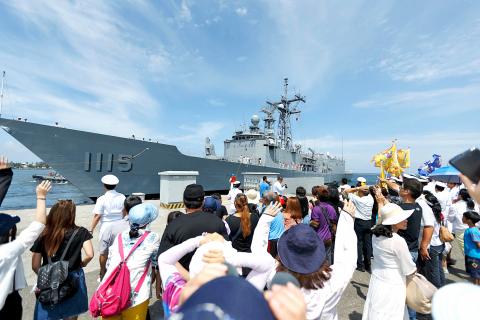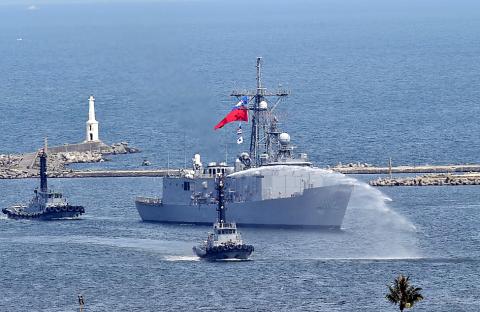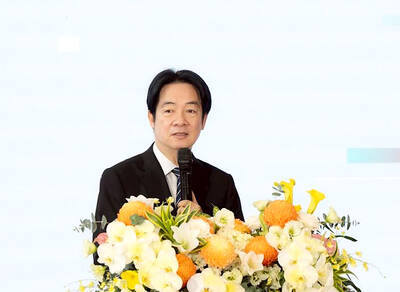Two Perry-class guided-missile frigates purchased from the US arrived in Kaohsiung yesterday, an acquisition that the Republic of China (ROC) Navy said will increase its anti-submarine capability.
Flying ROC national flags, the vessels, crewed by Taiwanese, sailed into Zuoying Military Harbor in Kaohsiung at about 9:30am, where a welcoming ceremony was held by the military.
A commissioning ceremony is slated for July next year, according to military sources.

Photo: CNA
The ships — which were cheaper than Taiwanese-made Cheng Kung-class frigates, the design of which is based on Perry-class frigates — were built in the 1980s.
The navy renamed them Ming Chuan No. 1112 and Feng Chia No. 1115.
They are to join the navy’s 146th fleet based on the outlying island of Penghu, from where they are to patrol the Taiwan Strait, the sources said.

Photo: Chang Chung-yi, Taipei Times
Perry-class frigates have high mobility and are equipped with the SQQ-89 undersea warfare combat system and the SQR-19 sonar system, both of which the military said would beef up its anti-submarine capabilities.
Then-US president Barack Obama signed a bill into law in December 2014 that authorized the sale of four Perry-class frigates to Taiwan.
Taipei budgeted about NT$5.5 billion (US$182 million at today’s exchange rate) in 2014 to purchase two of the ships, which were formerly named the USS Taylor (EFG-50) and the USS Gary (EFG-51) of the US Navy.
Admiral Huang Shu-kuang (黃曙光), commander of the ROC Navy, and family members of the crew were at the port to welcome the ships as they docked.
An official who declined to be named said the navy had been working with its US counterpart since May last year to bring the ships to Taiwan, adding that the crew underwent 10 months of tests and training with the US military.
The frigates are to be fitted with new equipment, while officers will be trained with the new ships before they are added into the naval force, the official said.
“Maintaining security and unimpeded passage in the waters around Taiwan is the navy’s greatest responsibility. We hope we will continue to have support in making arms purchases to ensure we can undertake this responsibility,” the sources said.
The numbering of the frigates — 1112 and 1115 — follows a convention in which the last two numbers of a ship’s name cannot add up to four, nor can the last digit be a four, the official said.
Case of all the digits adding up to four are also not used.
Four in Chinese has a similar pronunciation to the Chinese word for “die” (si, 死).
“The idea is that we hope officers will not be distracted by what might be perceived as an ominous ship name,” the official said, adding that as the previous Cheng Kung-class vessel to be added to the fleet was No. 1110, and 1111 adds up to four, the new ships were numbered starting from 1112.

MISINFORMATION: The generated content tends to adopt China’s official stance, such as ‘Taiwan is currently governed by the Chinese central government,’ the NSB said Five China-developed artificial intelligence (AI) language models exhibit cybersecurity risks and content biases, an inspection conducted by the National Security Bureau (NSB) showed. The five AI tools are: DeepSeek, Doubao (豆包), Yiyan (文心一言), Tongyi (通義千問) and Yuanbao (騰訊元寶), the bureau said, advising people to remain vigilant to protect personal data privacy and corporate business secrets. The NSB said it, in accordance with the National Intelligence Services Act (國家情報工作法), has reviewed international cybersecurity reports and intelligence, and coordinated with the Ministry of Justice Investigation Bureau and the National Police Agency’s Criminal Investigation Bureau to conduct an inspection of China-made AI language

LIMITS: While China increases military pressure on Taiwan and expands its use of cognitive warfare, it is unwilling to target tech supply chains, the report said US and Taiwan military officials have warned that the Chinese People’s Liberation Army (PLA) could implement a blockade within “a matter of hours” and need only “minimal conversion time” prior to an attack on Taiwan, a report released on Tuesday by the US Senate’s China Economic and Security Review Commission said. “While there is no indication that China is planning an imminent attack, the United States and its allies and partners can no longer assume that a Taiwan contingency is a distant possibility for which they would have ample time to prepare,” it said. The commission made the comments in its annual

CHECKING BOUNDARIES: China wants to disrupt solidarity among democracies and test their red lines, but it is instead pushing nations to become more united, an expert said The US Department of State on Friday expressed deep concern over a Chinese public security agency’s investigation into Legislator Puma Shen (沈伯洋) for “secession.” “China’s actions threaten free speech and erode norms that have underpinned the cross-strait ‘status quo’ for decades,” a US Department of State spokesperson said. The Chongqing Municipal Public Security Bureau late last month listed Shen as “wanted” and launched an investigation into alleged “secession-related” criminal activities, including his founding of the Kuma Academy, a civil defense organization that prepares people for an invasion by China. The spokesperson said that the US was “deeply concerned” about the bureau investigating Shen

‘TROUBLEMAKER’: Most countries believe that it is China — rather than Taiwan — that is undermining regional peace and stability with its coercive tactics, the president said China should restrain itself and refrain from being a troublemaker that sabotages peace and stability in the Indo-Pacific region, President William Lai (賴清德) said yesterday. Lai made the remarks after China Coast Guard vessels sailed into disputed waters off the Senkaku Islands — known as the Diaoyutai Islands (釣魚台) in Taiwan — following a remark Japanese Prime Minister Sanae Takaichi made regarding Taiwan. Takaichi during a parliamentary session on Nov. 7 said that a “Taiwan contingency” involving a Chinese naval blockade could qualify as a “survival-threatening situation” for Japan, and trigger Tokyo’s deployment of its military for defense. Asked about the escalating tensions